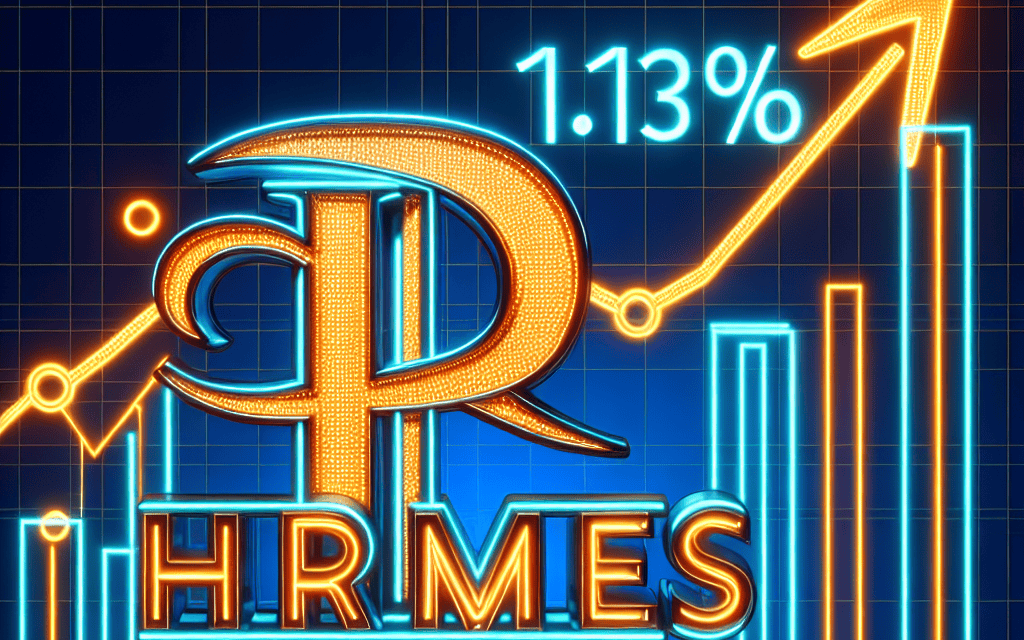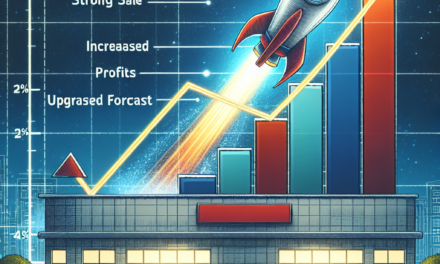“Hermès: Illuminating Luxury with a 11.3% Q3 Sales Surge.”
Introduction
In the third quarter of the fiscal year, luxury fashion house Hermès has reported a remarkable 11.3% increase in sales, underscoring its robust market position and the enduring appeal of its high-end products. This impressive growth trajectory highlights Hermès’ strategic prowess in navigating the complexities of the global luxury market, driven by strong demand across its diverse product lines, including leather goods, ready-to-wear, and accessories. The company’s ability to sustain such momentum amidst economic uncertainties and shifting consumer preferences is a testament to its brand strength, innovative craftsmanship, and commitment to quality. As Hermès continues to shine brighter in the luxury sector, this sales surge not only reinforces its status as a leader in the industry but also sets a promising tone for future performance.
Hermes’ Q3 Sales Surge: A Closer Look at the 11.3% Increase
In the third quarter of 2023, Hermes, the renowned French luxury goods manufacturer, reported an impressive 11.3% increase in sales, a testament to its enduring appeal and strategic market positioning. This surge in sales not only highlights the brand’s resilience in a competitive luxury market but also underscores its ability to adapt to evolving consumer preferences and global economic conditions. As we delve deeper into the factors contributing to this remarkable growth, it becomes evident that Hermes’ success is a result of a combination of strategic initiatives, product innovation, and a deep understanding of its clientele.
To begin with, Hermes has consistently demonstrated a commitment to craftsmanship and quality, which remains a cornerstone of its brand identity. This unwavering dedication to excellence has allowed the company to maintain its status as a symbol of luxury and exclusivity. By focusing on timeless designs and superior materials, Hermes continues to attract discerning customers who value authenticity and heritage. This approach has not only helped the brand retain its loyal customer base but also attract new clients seeking high-quality luxury goods.
Moreover, Hermes’ strategic expansion into emerging markets has played a crucial role in driving its sales growth. The brand has successfully tapped into the increasing demand for luxury products in regions such as Asia-Pacific, where rising disposable incomes and a growing middle class have fueled consumer spending. By establishing a strong presence in these markets, Hermes has been able to capitalize on new opportunities and diversify its revenue streams. This geographic diversification has proven to be a prudent strategy, particularly in light of economic uncertainties in more established markets.
In addition to geographic expansion, Hermes has also embraced digital transformation to enhance its customer experience and streamline operations. The brand’s investment in e-commerce platforms and digital marketing has enabled it to reach a broader audience and engage with customers in innovative ways. By leveraging technology, Hermes has been able to offer personalized shopping experiences, which have become increasingly important in today’s digital age. This focus on digital innovation has not only boosted online sales but also strengthened the brand’s overall market presence.
Furthermore, product innovation has been a key driver of Hermes’ sales growth. The brand has consistently introduced new collections and limited-edition items that resonate with its target audience. By staying attuned to fashion trends and consumer preferences, Hermes has been able to maintain its relevance in a rapidly changing market. The introduction of new product lines, such as sustainable and eco-friendly offerings, has also appealed to environmentally conscious consumers, further broadening the brand’s appeal.
Lastly, Hermes’ ability to maintain strong relationships with its suppliers and partners has ensured a seamless supply chain, even amid global disruptions. This operational efficiency has allowed the brand to meet customer demand without compromising on quality or delivery timelines. By fostering collaboration and transparency with its partners, Hermes has been able to navigate challenges and sustain its growth trajectory.
In conclusion, Hermes’ 11.3% sales surge in the third quarter of 2023 is a reflection of its strategic foresight, commitment to quality, and adaptability in a dynamic market. By focusing on craftsmanship, expanding into new markets, embracing digital innovation, and introducing new products, Hermes has solidified its position as a leader in the luxury goods industry. As the brand continues to evolve, it remains well-positioned to capitalize on future opportunities and maintain its legacy of excellence.
Key Factors Behind Hermes’ Impressive 11.3% Sales Growth in Q3
In the third quarter of 2023, Hermes, the renowned French luxury brand, reported an impressive 11.3% increase in sales, a testament to its enduring appeal and strategic acumen in navigating the complexities of the global market. This remarkable growth can be attributed to several key factors that have collectively bolstered the brand’s performance during this period.
To begin with, Hermes has consistently maintained its reputation for exceptional craftsmanship and exclusivity, which continues to resonate with affluent consumers worldwide. The brand’s commitment to quality and its meticulous attention to detail have ensured that its products remain highly coveted. This dedication to excellence is evident in its iconic offerings, such as the Birkin and Kelly bags, which have not only retained their status symbols but have also seen increased demand. By focusing on its core values and heritage, Hermes has successfully differentiated itself from competitors, thereby attracting a loyal customer base that values authenticity and timeless elegance.
Moreover, Hermes has adeptly expanded its product range to cater to evolving consumer preferences. The brand has introduced innovative designs and diversified its offerings, including ready-to-wear collections, footwear, and home goods, which have been well-received by the market. This strategic diversification has allowed Hermes to capture a broader audience while maintaining its luxury positioning. Additionally, the brand’s foray into digital channels has further amplified its reach. By enhancing its online presence and investing in e-commerce platforms, Hermes has effectively tapped into the growing trend of online luxury shopping, thereby driving sales growth.
Another significant factor contributing to Hermes’ robust performance is its strategic global expansion. The brand has been proactive in strengthening its presence in key international markets, particularly in Asia, where the appetite for luxury goods remains strong. By opening new stores and enhancing its distribution network in regions such as China and Southeast Asia, Hermes has capitalized on the burgeoning demand from affluent consumers in these areas. This geographical diversification has not only mitigated risks associated with market volatility but has also provided a steady stream of revenue from diverse sources.
Furthermore, Hermes’ commitment to sustainability and ethical practices has resonated with a growing segment of environmentally conscious consumers. The brand’s efforts to reduce its carbon footprint, implement sustainable sourcing practices, and promote social responsibility have enhanced its appeal among discerning buyers who prioritize ethical consumption. By aligning its business practices with the values of its target audience, Hermes has strengthened its brand equity and fostered customer loyalty.
In addition to these strategic initiatives, Hermes has benefited from favorable macroeconomic conditions, including a resurgence in consumer spending on luxury goods as global economies recover from the pandemic-induced downturn. The easing of travel restrictions and the return of international tourism have also contributed to increased foot traffic in Hermes’ flagship stores, further boosting sales.
In conclusion, Hermes’ impressive 11.3% sales growth in the third quarter of 2023 is the result of a multifaceted approach that combines a steadfast commitment to quality, strategic product diversification, global expansion, and a focus on sustainability. By leveraging these key factors, Hermes has not only reinforced its position as a leader in the luxury market but has also set a strong foundation for continued success in the future. As the brand continues to innovate and adapt to changing market dynamics, it is well-positioned to maintain its upward trajectory and shine even brighter in the competitive landscape of luxury fashion.
How Hermes Outshone Competitors with a 11.3% Sales Boost in Q3
In the competitive landscape of luxury fashion, Hermes has once again demonstrated its prowess by achieving an impressive 11.3% sales surge in the third quarter. This remarkable performance not only underscores the brand’s enduring appeal but also highlights its strategic acumen in navigating the complexities of the global market. As the luxury sector grapples with fluctuating consumer preferences and economic uncertainties, Hermes’ ability to outshine its competitors is a testament to its robust business model and innovative approach.
One of the key factors contributing to Hermes’ success is its unwavering commitment to craftsmanship and quality. Unlike many of its peers who have expanded their product lines to include more accessible offerings, Hermes has remained steadfast in its dedication to producing meticulously crafted goods. This focus on quality over quantity has cultivated a loyal customer base that values exclusivity and is willing to invest in timeless pieces. Consequently, Hermes has been able to maintain its brand prestige, which is crucial in the luxury market where brand perception is paramount.
Moreover, Hermes’ strategic expansion into emerging markets has played a significant role in its sales growth. By tapping into regions with burgeoning affluent populations, such as Asia-Pacific, the brand has effectively broadened its customer base. This geographic diversification not only mitigates risks associated with economic downturns in specific regions but also positions Hermes to capitalize on new growth opportunities. The brand’s ability to adapt its marketing strategies to resonate with diverse cultural contexts further enhances its appeal across different markets.
In addition to geographic expansion, Hermes has also embraced digital transformation to enhance its customer experience. The integration of digital technologies into its operations has allowed the brand to offer a seamless omnichannel experience, catering to the evolving preferences of tech-savvy consumers. By investing in e-commerce platforms and digital marketing, Hermes has successfully bridged the gap between traditional luxury retail and modern consumer expectations. This digital pivot has not only driven online sales but also strengthened customer engagement, fostering a deeper connection with the brand.
Furthermore, Hermes’ commitment to sustainability has resonated with environmentally conscious consumers, setting it apart from competitors. In an era where sustainability is increasingly influencing purchasing decisions, Hermes’ efforts to incorporate eco-friendly practices into its production processes have bolstered its brand image. By prioritizing sustainable sourcing and reducing its carbon footprint, the brand has demonstrated its dedication to ethical luxury, appealing to a growing segment of consumers who prioritize environmental responsibility.
While Hermes’ Q3 performance is undoubtedly impressive, it is also indicative of broader trends within the luxury sector. As consumer preferences continue to evolve, brands that prioritize quality, embrace digital innovation, and commit to sustainability are likely to thrive. Hermes’ ability to align its business strategies with these trends has not only driven its recent sales surge but also positioned it for sustained success in the future.
In conclusion, Hermes’ 11.3% sales boost in the third quarter is a reflection of its strategic foresight and adaptability in a dynamic market. By maintaining its focus on craftsmanship, expanding into emerging markets, leveraging digital technologies, and championing sustainability, Hermes has not only outperformed its competitors but also reinforced its status as a leader in the luxury fashion industry. As the brand continues to navigate the challenges and opportunities of the global market, its commitment to excellence will undoubtedly remain a key driver of its success.
The Impact of Hermes’ 11.3% Sales Surge on the Luxury Market

In the third quarter of 2023, Hermes, the renowned French luxury brand, reported an impressive 11.3% surge in sales, a development that has sent ripples through the luxury market. This remarkable growth not only underscores Hermes’ enduring appeal but also highlights significant trends and shifts within the broader luxury sector. As the brand continues to captivate consumers worldwide, its performance offers valuable insights into the evolving dynamics of luxury consumption.
To begin with, Hermes’ sales surge can be attributed to several key factors. The brand’s unwavering commitment to craftsmanship and exclusivity remains a cornerstone of its success. In an era where consumers increasingly seek authenticity and quality, Hermes’ dedication to artisanal excellence resonates deeply. This commitment is evident in its meticulously crafted leather goods, iconic silk scarves, and timeless fashion pieces, which continue to attract discerning buyers. Moreover, Hermes’ ability to maintain a sense of scarcity and exclusivity, even as it expands its product offerings, has proven to be a winning strategy.
Furthermore, the brand’s strategic expansion into emerging markets has played a pivotal role in its recent success. As the global economy continues to recover, affluent consumers in regions such as Asia and the Middle East are driving demand for luxury goods. Hermes has adeptly positioned itself to capitalize on this trend by opening new stores and enhancing its digital presence in these high-growth areas. This expansion not only boosts sales but also strengthens the brand’s global footprint, ensuring its relevance in an increasingly interconnected world.
In addition to geographic expansion, Hermes’ embrace of digital innovation has been instrumental in its sales surge. The luxury market, traditionally characterized by in-person shopping experiences, has witnessed a digital transformation in recent years. Hermes has successfully navigated this shift by investing in e-commerce platforms and enhancing its online shopping experience. By seamlessly integrating digital and physical retail, the brand has managed to cater to a broader audience while maintaining its hallmark exclusivity. This approach has not only driven sales but also reinforced customer loyalty, as consumers appreciate the convenience and personalized service that Hermes offers.
The impact of Hermes’ sales surge extends beyond the brand itself, influencing the broader luxury market. As one of the industry’s leading players, Hermes sets a benchmark for excellence and innovation. Its success serves as a bellwether for other luxury brands, prompting them to reevaluate their strategies and adapt to changing consumer preferences. In particular, the emphasis on craftsmanship, exclusivity, and digital engagement is likely to shape the future of luxury retail. Brands that can effectively balance these elements are poised to thrive in an increasingly competitive landscape.
Moreover, Hermes’ performance underscores the resilience of the luxury market in the face of economic uncertainties. Despite global challenges, such as inflation and geopolitical tensions, the demand for luxury goods remains robust. This resilience is driven by a growing cohort of affluent consumers who prioritize quality and exclusivity over price. As a result, luxury brands that can deliver on these expectations are well-positioned to weather economic fluctuations and continue their growth trajectory.
In conclusion, Hermes’ 11.3% sales surge in the third quarter of 2023 is a testament to the brand’s enduring appeal and strategic acumen. By focusing on craftsmanship, expanding into emerging markets, and embracing digital innovation, Hermes has not only bolstered its own success but also set a precedent for the luxury market as a whole. As the industry continues to evolve, the lessons gleaned from Hermes’ performance will undoubtedly shape the future of luxury consumption.
Analyzing Hermes’ Strategies for Achieving 11.3% Sales Growth in Q3
In the third quarter of 2023, Hermes, the renowned French luxury brand, reported an impressive 11.3% increase in sales, a testament to its robust business strategies and enduring appeal in the luxury market. This remarkable growth can be attributed to several key factors that have been instrumental in driving the brand’s success. By examining these strategies, we can gain a deeper understanding of how Hermes continues to thrive in an increasingly competitive landscape.
To begin with, Hermes has consistently maintained its reputation for exceptional craftsmanship and exclusivity, which are cornerstones of its brand identity. The company has long been known for its meticulous attention to detail and the use of high-quality materials, ensuring that each product is a masterpiece in its own right. This commitment to excellence not only attracts affluent customers but also fosters brand loyalty, as consumers are willing to invest in products that promise longevity and timeless elegance. Consequently, Hermes’ unwavering dedication to quality has played a significant role in sustaining its growth trajectory.
Moreover, Hermes has adeptly navigated the challenges posed by the global economic environment by strategically expanding its product offerings. While the brand is traditionally associated with its iconic leather goods, it has successfully diversified its portfolio to include a wide range of products such as ready-to-wear clothing, accessories, and home furnishings. This diversification has allowed Hermes to tap into new customer segments and mitigate risks associated with over-reliance on a single product category. By broadening its appeal, the brand has been able to capture a larger share of the luxury market, thereby contributing to its impressive sales performance.
In addition to product diversification, Hermes has also embraced digital transformation as a means of enhancing customer engagement and driving sales. The brand has invested significantly in its online presence, ensuring that its digital platforms offer a seamless and immersive shopping experience. By leveraging cutting-edge technology, Hermes has been able to reach a global audience and cater to the evolving preferences of tech-savvy consumers. This digital strategy has not only bolstered sales but also reinforced the brand’s image as a forward-thinking luxury leader.
Furthermore, Hermes’ strategic expansion into emerging markets has been a crucial factor in its recent sales surge. Recognizing the growing demand for luxury goods in regions such as Asia-Pacific and the Middle East, the brand has made concerted efforts to establish a strong foothold in these markets. By opening new stores and enhancing its distribution networks, Hermes has been able to capitalize on the increasing purchasing power of consumers in these areas. This geographic diversification has provided the brand with a significant growth avenue, further solidifying its position as a global luxury powerhouse.
Lastly, Hermes’ commitment to sustainability and ethical practices has resonated with consumers who are increasingly conscious of the environmental and social impact of their purchases. The brand’s initiatives to promote sustainable sourcing and production processes have not only enhanced its corporate reputation but also attracted a new generation of environmentally aware customers. This alignment with consumer values has undoubtedly contributed to Hermes’ continued success.
In conclusion, Hermes’ 11.3% sales growth in the third quarter of 2023 is a testament to its effective strategies in maintaining brand exclusivity, diversifying its product offerings, embracing digital transformation, expanding into emerging markets, and committing to sustainability. These strategic initiatives have enabled Hermes to navigate the complexities of the luxury market and emerge as a shining example of resilience and innovation. As the brand continues to evolve, it is well-positioned to sustain its growth and maintain its status as a leader in the luxury industry.
Consumer Trends Driving Hermes’ 11.3% Sales Increase in Q3
In the third quarter of 2023, Hermès, the renowned French luxury brand, reported an impressive 11.3% increase in sales, a testament to its enduring appeal and strategic market positioning. This surge in sales can be attributed to several consumer trends that have been shaping the luxury market landscape. As the global economy continues to recover from the disruptions caused by the pandemic, consumer confidence has been steadily rising, leading to increased spending on luxury goods. Hermès, with its reputation for timeless elegance and superior craftsmanship, has been a significant beneficiary of this trend.
One of the key drivers of Hermès’ sales growth is the increasing demand for high-quality, sustainable products. In recent years, consumers have become more conscious of the environmental and ethical implications of their purchases. Hermès has responded to this shift by emphasizing its commitment to sustainable practices, from sourcing materials responsibly to ensuring fair labor conditions. This alignment with consumer values has not only enhanced the brand’s image but also attracted a new generation of environmentally conscious luxury buyers.
Moreover, the brand’s strategic expansion into emerging markets has played a crucial role in its sales performance. As wealth continues to grow in regions such as Asia and the Middle East, there is a burgeoning appetite for luxury goods. Hermès has capitalized on this opportunity by opening new stores and enhancing its digital presence in these areas, making its products more accessible to affluent consumers. This expansion strategy has been instrumental in driving sales growth, as evidenced by the strong performance in these markets.
In addition to geographical expansion, Hermès has also focused on diversifying its product offerings to cater to evolving consumer preferences. While the brand is traditionally known for its iconic leather goods, it has successfully expanded into other categories such as ready-to-wear, jewelry, and homeware. This diversification has allowed Hermès to capture a broader audience and increase its market share. The introduction of innovative designs and limited-edition collections has further fueled consumer interest, creating a sense of exclusivity and urgency that drives sales.
The digital transformation of the retail landscape has also been a significant factor in Hermès’ success. The brand has invested heavily in enhancing its online presence, providing a seamless and personalized shopping experience for its customers. By leveraging digital tools and platforms, Hermès has been able to engage with consumers more effectively, offering virtual consultations and exclusive online events. This digital strategy has not only increased brand visibility but also facilitated direct communication with customers, fostering loyalty and repeat purchases.
Furthermore, the resurgence of experiential luxury has contributed to Hermès’ sales growth. As consumers increasingly seek unique and memorable experiences, Hermès has responded by offering personalized services and bespoke products. This focus on creating exceptional customer experiences has strengthened the brand’s relationship with its clientele, encouraging higher spending and brand advocacy.
In conclusion, Hermès’ 11.3% sales increase in the third quarter of 2023 is a reflection of its ability to adapt to changing consumer trends and market dynamics. By aligning with consumer values, expanding into new markets, diversifying its product range, embracing digital transformation, and prioritizing experiential luxury, Hermès has positioned itself as a leader in the luxury industry. As these trends continue to evolve, Hermès is well-equipped to maintain its growth trajectory and further solidify its status as a symbol of luxury and sophistication.
Future Prospects for Hermes After a Successful 11.3% Sales Surge in Q3
Hermes, the iconic French luxury brand, has recently reported an impressive 11.3% surge in sales for the third quarter, a testament to its enduring appeal and strategic prowess in the luxury market. This remarkable growth not only underscores Hermes’ resilience in a competitive industry but also sets the stage for promising future prospects. As the brand continues to captivate consumers worldwide, it is essential to explore the factors contributing to this success and the potential pathways for sustained growth.
To begin with, Hermes’ ability to maintain its allure lies in its unwavering commitment to craftsmanship and exclusivity. The brand’s dedication to producing high-quality, artisanal products has long been a cornerstone of its identity, attracting discerning customers who value timeless elegance. This focus on quality over quantity has allowed Hermes to cultivate a loyal customer base, which has been instrumental in driving sales growth. Moreover, the brand’s strategic decision to limit production and maintain scarcity has further enhanced its desirability, creating a sense of urgency among consumers to acquire its coveted products.
In addition to its craftsmanship, Hermes has adeptly navigated the evolving digital landscape, leveraging technology to enhance customer engagement and expand its reach. The brand’s investment in digital platforms has facilitated seamless online shopping experiences, catering to the growing demand for luxury e-commerce. By integrating digital innovation with its traditional retail model, Hermes has successfully bridged the gap between the physical and virtual worlds, offering customers a holistic shopping experience. This digital transformation has not only contributed to the recent sales surge but also positions Hermes favorably for future growth in an increasingly digitalized market.
Furthermore, Hermes’ strategic expansion into emerging markets has played a pivotal role in its recent success. The brand’s targeted efforts to establish a presence in regions such as Asia-Pacific have yielded significant returns, as evidenced by robust sales figures in these areas. By tapping into the burgeoning affluence of consumers in these markets, Hermes has effectively diversified its revenue streams and mitigated risks associated with economic fluctuations in more established markets. This geographic diversification is likely to continue driving growth, as the brand capitalizes on the rising demand for luxury goods in these regions.
Looking ahead, Hermes is well-positioned to sustain its growth trajectory by continuing to innovate while staying true to its heritage. The brand’s ongoing commitment to sustainability and ethical practices is expected to resonate with increasingly conscientious consumers, further enhancing its appeal. By prioritizing sustainable sourcing and production methods, Hermes not only aligns itself with global environmental trends but also reinforces its reputation as a responsible luxury brand.
Moreover, Hermes’ focus on expanding its product offerings, particularly in categories such as ready-to-wear and accessories, presents additional opportunities for growth. By broadening its portfolio, the brand can attract new customer segments and increase its market share. This strategic diversification, coupled with its core strengths, will likely enable Hermes to navigate future challenges and capitalize on emerging opportunities.
In conclusion, Hermes’ impressive 11.3% sales surge in the third quarter is a testament to its enduring appeal and strategic acumen. By maintaining its commitment to craftsmanship, embracing digital innovation, and expanding into emerging markets, the brand has laid a solid foundation for future growth. As Hermes continues to evolve and adapt to changing consumer preferences, it is poised to shine even brighter in the global luxury landscape.
Q&A
1. **What is the main highlight of Hermes’ Q3 performance?**
Hermes reported an 11.3% increase in sales for the third quarter.
2. **What factors contributed to Hermes’ sales surge in Q3?**
The sales surge was driven by strong demand for luxury goods, particularly in the Asia-Pacific region and robust performance across various product categories.
3. **How did Hermes perform in the Asia-Pacific region during Q3?**
Hermes experienced significant growth in the Asia-Pacific region, contributing substantially to the overall sales increase.
4. **Which product categories saw the most growth for Hermes in Q3?**
Leather goods and ready-to-wear categories were among the top performers, showing strong sales growth.
5. **How does Hermes’ Q3 performance compare to previous quarters?**
The 11.3% sales increase in Q3 represents a continuation of positive growth trends seen in previous quarters, indicating sustained demand for Hermes products.
6. **What are Hermes’ expectations for future performance following the Q3 results?**
Hermes remains optimistic about future growth, expecting continued demand for luxury goods and expansion in key markets.
7. **How has the market reacted to Hermes’ Q3 sales results?**
The market has responded positively, with increased investor confidence and a potential rise in stock prices following the announcement of the sales surge.
Conclusion
Hermès demonstrated robust financial performance in the third quarter, achieving an impressive 11.3% increase in sales. This surge underscores the brand’s strong market position and effective strategies in luxury retail, driven by high demand for its premium products and successful expansion efforts. The growth reflects Hermès’ ability to navigate economic challenges while maintaining its reputation for exclusivity and quality, positioning the company for continued success in the competitive luxury market.





